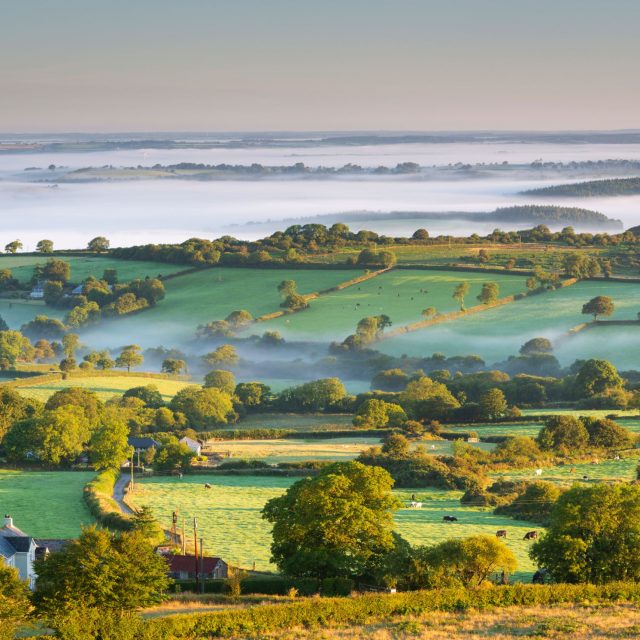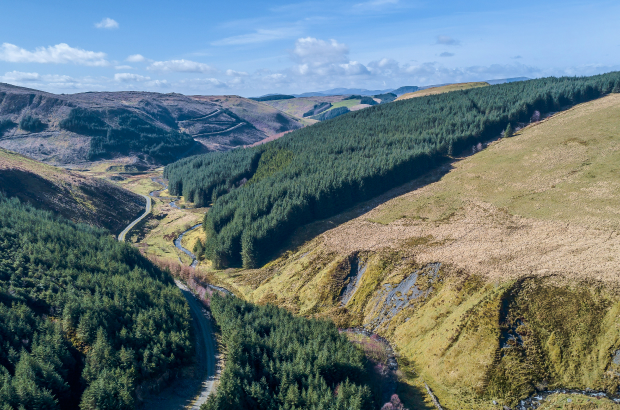Land Business | Seeds of change: The UK’s changing conditions for the arable sector
The UK’s warming climate and widespread resistance to pest and disease controls threaten the profitability of the traditional arable sector. But could newcomer crops such as soya, lupins and quinoa thrive in these changing conditions?
The business of crop production in the UK looks set to get tougher in the coming years. While farm owners await the results of complex negotiations over Brexit and the UK’s future agricultural policy, change is already afoot in arable farming.
Disease- and weed-control chemicals are becoming less effective, climate change is disrupting traditional growing patterns, and, with Basic Payments likely to be removed and conventional crops grown more cheaply elsewhere in the world, the profitability of the sector is under threat.
But amid the challenges, there are opportunities for the arable industry. For example, a warmer climate could enable more farmers to grow alternative crops such as soya, grain maize, sunflowers and lupins, while modern diets mean that niche crops such as quinoa are becoming more profitable. So is it time to consider changing crop rotations to some of these alternatives?
Climate change is likely to mean that the UK’s moderate, predictable weather will be slowly lost, and replaced with extreme events of prolonged drought or excess rainfall.
According to the Met Office, nine of the UK’s 10 warmest years on record have occurred since 2002, with the 10 warmest years all happening since 1990. Meanwhile, seven of our 10 wettest years have come since 1998. The once-reliable pattern of precipitation is shifting, too – the UK’s summer rainfall is decreasing on average, while winter’s share of rainfall is increasing.
‘Future weather patterns are likely to be bumpy,’ agrees Jock Willmott, an agronomist in Strutt & Parker’s Cambridge office. ‘Higher summer temperatures have the potential to induce more crop stress, reducing quality and yields, and place pressure on abstraction and stored water resources – though if there is more winter rainfall, optimistically this may balance out.
‘We could face a reduction in spray days due to waterlogging, as well as less assistance from natural factors such as frosts or dry weather to control certain pests, diseases and weeds.’
Chemical reactions
Furthermore, the rising costs of agrochemical resistance will only worsen the problem. ‘Resistance is well documented in blackgrass, ryegrass, Septoria in wheat and Rhynchosporium in barley,’ says Willmott, ‘while resistance to pyrethroid insecticides is so widespread in flea, pollen and bruchid beetles, the pea and bean weevil, and aphids, they’re nearing a point of being completely ineffective.’
In its 2009 UK Climate Projections report, Defra predicted that average UK summer temperatures will rise by 3-4°C by 2080, putting our climate on a par with the south of France.
‘Of course, if this were to happen, farming businesses and cropping will be able to adapt,’ says Willmott. ‘This means earlier springs, longer growing seasons and warmer autumns, which could open up the potential to grow new crops not yet widely grown in the UK.’
The rotation of crops will be key to the future of arable profitability. But with less chemical control and the potential of far tighter margins, a rotation that adds yield and saves cost is a must, warns Willmott.
‘The rotation needs to be robust and resilient to extremes of weather,’ he says. ‘The crops – so far as possible – need to complement each other to improve soil microflora, reduce soil-borne pests and disease, offer opportunities to improve drainage, and reduce grass weed burden. But most of all, they need to be profitable.’
So which alternative crops might farms consider planting? Ultimately, it will depend on local land and climate conditions, and the wider level of demand for a particular crop.
Stephen Jones is the Director of the British Quinoa Company in Shropshire. After reading about the trend for eating quinoa due to its high nutritional value, in 2013 he tried growing the crop on his family’s traditional arable farm. From an initial crop of around 20 tonnes, the farm now harvests upwards of 700 tonnes of quinoa annually – the bulk of which is supplied to the likes of Waitrose, Marks & Spencer and Pret A Manger for their prepared salads.
‘We turned to quinoa as something that could help us diversify away from wheat and oilseed rape,’ Jones explains. ‘Although we still grow wheat, rape and barley, quinoa has become an ideal alternative crop in the rotation – and we’re increasing its allocation year on year.’
Jones attributes much of his success to the British public’s shifting palette. More people are choosing to eat alternatives to rice and wheat, while the restaurants and supermarkets the farm supplies are keen to reduce their food miles by sourcing quinoa locally.
The newcomer crop is not too much trouble to grow, either. ‘Considering quinoa is not a species native to Britain, it grows pretty well as long as you have the right variety, and you understand the crop fully,’ Jones says.
Soya is also gaining a following among consumers. ‘The future demand for soya looks strong, with it being used as a meat protein substitute in vegetarian diets, and soya milk providing an increasingly popular alternative to traditional dairy milk,’ says Willmott.
The legume is currently grown in the UK mostly for inclusion in animal feeds as a source of quality vegetable protein. As it’s free from genetic modification, it can command a premium over imported soya, with prices recently increasing to £375-£400 per tonne.
‘Coupled with the issues oilseed rape has experienced due to flea beetle, we have seen the area of soya crop grown in the UK increase to approximately 5,000 acres,’ says Willmott. ‘Soya would certainly suit a warmer, sunnier UK and, as such a globally dominant crop, it has already been well researched.’
However, there are two barriers preventing the widespread growth of soya. The UK’s huge pigeon population is a menace to the crop in its early stages, as it emerges in a period when there is little else available for them to feed on. Furthermore, its late harvesting date – late September or early October – generally means it is best kept on lighter to medium-heavy land.
Dr Lydia Smith, head of the National Institute of Agricultural Botany’s (NIAB) Innovation Farm, says: ‘The cultivation of soya has come on leaps and bounds over the last decade, with new varieties coming through that have a much better ability to grow and get established much earlier in the year, so they can be harvested in time to get the following crop in. It really is a viable crop now in certain seasons, providing the soil isn’t too light and there are no irrigation problems.’
A blooming future
Similar to soya, white lupins are increasingly being grown for animal feed. Andrew Probert, Managing Director of Hampshirebased Premium Crops, says that lupins are an excellent source of protein that – unlike soya – do not have to be treated.
‘If we are going to see average temperatures rise in the UK, then crops like lupins could benefit, as they suit a more Mediterranean climate,’ he says. ‘Having said that, growing 10 hectares of lupins would produce about 30 tonnes of crops, which is usually sufficient for a couple of years’ worth of feed for a sheep farmer. So I doubt we will see hundreds of thousands of hectares of lupins being grown in the UK. Also, they are limited to the later end of the spectrum for harvesting, which is off-putting for many farmers.’
Alternative crops are also increasingly cultivated specifically for the UK’s bioenergy and biopharmaceutical industries. For example, some farmers are setting aside land to grow poppies exclusively for major drug companies, while grain maize is slowly attracting a following in the south.
‘Maize crops are now grown from dedicated varieties, bred to produce high grain yields for feeding to livestock,’ says Willmott, ‘while some is making it into the pet food market.
‘If established well, maize is a crop that thrives in warm, sunny conditions. Therefore, greater levels of sunlight in the future could open up the potential to grow more of this crop in the UK, as it would help it mature earlier.’
On the one hand, the inadvertently positive aspects of climate change could herald a new dawn in the growth of alternative arable crops in the UK. ‘However, as our dry summer demonstrated,’ says Jones, ‘the unpredictability of extreme events associated with climate change will make conditions more challenging.’
jock.willmott@struttandparker.com
Could vineyards be a long-term alternative to arables?
The English wine industry is blossoming. Over the past decade, the area of land planted with vineyards has increased by 140%, and total production is averaging nearly four million bottles a year.
Currently, 66% of English wine is sparkling, but only 1% of sparkling wine consumed in the UK is produced at home, so there is huge potential for growth.
‘A lot of fruit farms have ideal land for vineyards, plus they already have the right skill sets and equipment,’ explains Nigel Porter, viticulture expert in Strutt & Parker’s Canterbury office.
‘Many arable farms with south-facing, sheltered land below 100m will diversify into viticulture – particularly if they are on chalk soil, which is low-yielding for arables but makes the best-quality sparkling wine.’
The south of England is generally considered to be warm enough for growing vines – Kent in particular, as it is a degree warmer than surrounding counties.
‘Even so, we are still 2-3°C colder than the Champagne region, where yields are significantly higher,’ says Porter. ‘But warmer temperatures will mean some parts of Champagne may soon become too hot, which could benefit us.’






